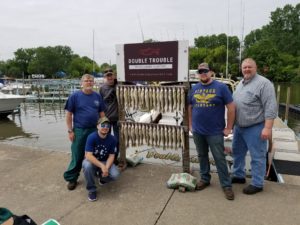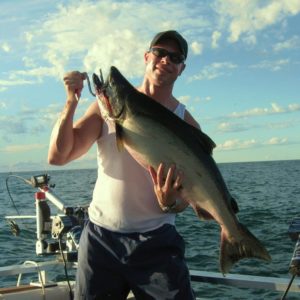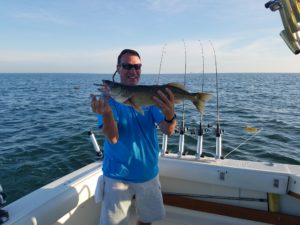Often times fishing calls for diverse methods and tactics that defy the obvious mainstream techniques that the majority of fishermen employ. Those that break away from the crowd and diversify their methods are often rewarded for the extra effort. This can be especially true when fishing the often heavily pressured waters of Saginaw Bay, Lake St. Clair, and Lake Erie, our state’s hottest walleye destinations. Usually the techniques from boat to boat are similar if not identical. It makes you wonder if during periods of high fishing pressure and low fish activity, if the fish actually recognize your techniques before you even launch your boat. There will always be times when your tried and true methods falter, when this happens it is always good to have another trick up your sleeve.
Day in and day out the most effective technique for putting walleye in the boat is trolling. The reason for this is simple: you are putting more lures in the water and constantly covering new water, which will almost always put more fish in the cooler. There are times that other methods can be effective such as when the fish are holding tight to structure, they are located in small schools, or during the spawn when the fish are actively tending nests. Other than these select times, trolling is definitely your best bet for taking a boatload of walleye.
Trolling for walleye has changed dramatically during the last 25 years. In the early years pulling crankbaits was usually the method of choice for most anglers. The most popular types of them were Storm Wiggle Warts, Cotton Cordell Wally Divers, Rapala Shad Raps, along with a variety of others. As fishing techniques have evolved throughout the years, trolling with crankbaits has taken a backseat. Today the most common means of trolling for walleye is with either a variety of small trolling spoons that have become popular in recent years, or using a bottom bouncer tipped with a night crawler harness.
Trolling spoons is likely the most popular way to fish for suspended open water walleye and for good reason: they are relatively simple to use but very effective. Trolling crawler harnesses is not as popular not because of its lack of effectiveness, but likely because most fisherman don’t want to go through the hassle of constantly baiting each rig. With these new methods of trolling, crankbaits have taken a backseat to the more modern innovations, despite the fact that they can still be a very productive way to put fish in the boat.
But as stated earlier, there are times when traditional methods will fail and you must use modification in order to be effective. Sometimes having just one type of lure in the water simply isn’t enough.
Before the popularization of small diving planers such as Luhr Jensen Jet Divers and Big Jon Mini Discs fisherman needed a way to get small walleye spoons into the strike zone of the fish. Some used lead core line while others used downriggers, but there was still not a great way to get a series of these lures to the proper depth within a planer board spread. Because of this problem, a technique was developed that always seemed to be kept a secret among charter captains and saavy anglers. This technique, which is known as a double rig, uses a deep-diving crankbait to achieve the proper depth for both itself and the spoon.
To begin using this method, you must first make the rig itself. To start you need a spool of 10-14 pound monofilament line. I use fluorocarbon as an attempt to hide the extra hardware that will be put on the rig. Along with that you will also need a three-way swivel, a cross-lock snap, and a single ball bearing swivel.
Once you have all of the items necessary, start by tying a leader from the three-way swivel to the snap. This should be rather short, anywhere from 10-16 inches, which will be the leader to the deep diving crankbait. It is important not to make this too long, because the longer the leader the more apt it will be to cause tangles. The next step is to tie another leader from the three-way swivel to the single ball bearing swivel, in order to make the trailer that will go to the spoon. This leader should be much longer, usually about 36-48 inches to insure that it is well behind the crankbait. It should be not that if you make the trailing leader too long, it will make it very difficult to net fish.
Once you have the rig itself constructed, it is time to put the lures that will be used on it. Depending on the water depth that I am fishing, I will choose a variety of diving baits. In shallow water of 20 feet or less, I use lures such as a Reef Runner Deep Lil’ Ripper, Storm Wiggle Wart (3/8 oz.), or a Rapala Down Deep Husky Jerk, (DHJ-10 or DHJ-12). In deep water I will increase the size of the bait and use lures such as a 9A Bomber or a Reef Runner Deep Diver. The spoons I use are usually the same whether I am in deep or shallow water and include, Michigan Stinger Scorpions, Wolverine Tackle Jr. Streaks, and Dreamweaver WDs. But remember that these are just suggestions and can be adjusted to meet your specific fishing situation. When using this type of setup it is imperative that the crankbait is tuned, or the erratic action will surely cause a major tangle problem.
The true beauty of this technique is the versatility of it. Take a few minutes before your next fishing trip and tie up a few of these rigs for a slow day when the fish are not cooperating. You never know when they may come in handy.



